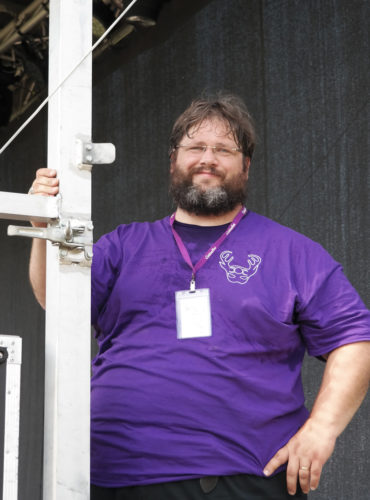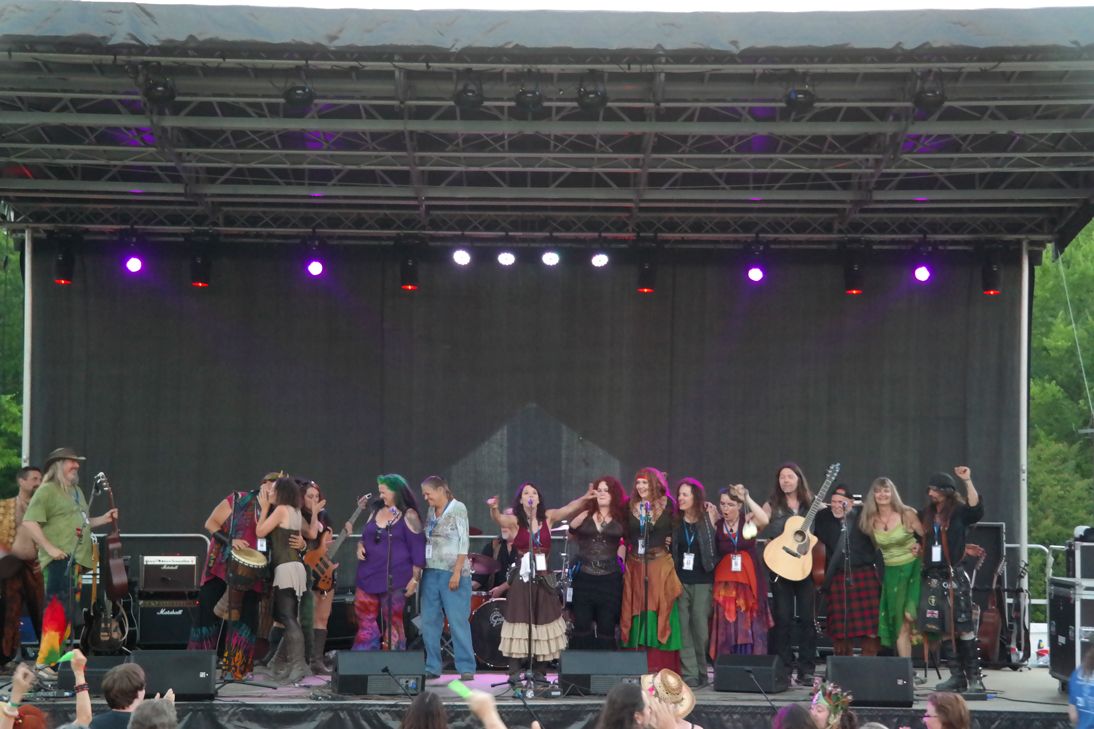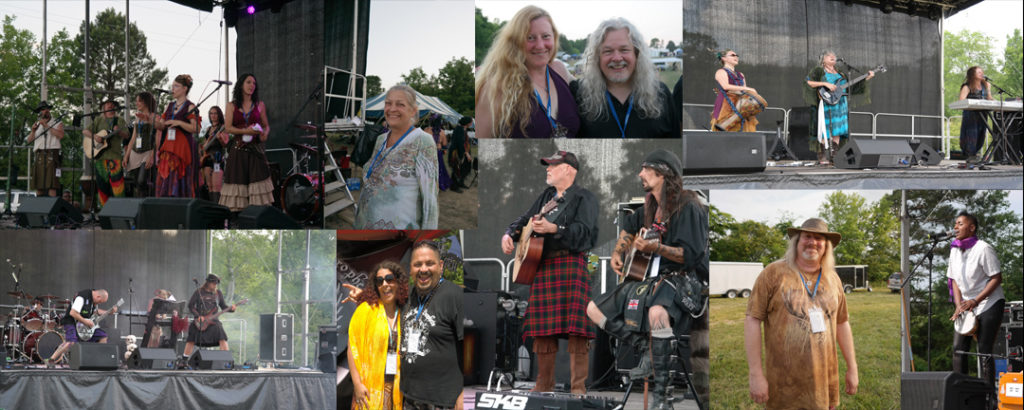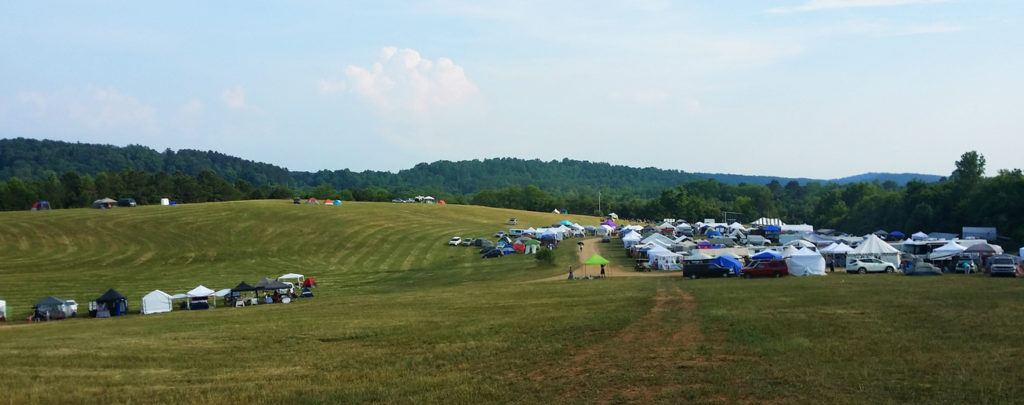I think a little trip in the WABAC (Wayback) Machine is in order. In 1982, Chris De Burgh released an album called “The Getaway.” The most famous song, by far I would guess, was “Don’t Pay the Ferryman,” an art rock piece describing the voyage of a soul over –- presumably -– the River Styx and warned to keep his obulos from the ferryman until the voyage reaches the other side. On the flip side of the album (a literal location back then) was a short song called “Where Peaceful Waters Flow.” This song is full of Anglocentric imagery that effortlessly echoes Pagan themes. It could as readily be both a song to a beloved as it could be a song to the Goddess.

David Banach of CalderaFest Photo credit: M. Tejeda-Moreno
To a freshly-minted witch still experiencing Pagan first fervor, it was a rare find. Locating any Pagan-centered music was sporadic, at best. You would hear of music titles in gatherings and grand covens; knowledge of them would spread by word of mouth at such events but getting a copy would become a major feat. For example, locating Gwydion Pendderwen’s album “Songs for the Old Religion” (1975) required a visit to the local record store and search through a seven-inch-thick tome of thin, near transparent yellow paper printed with 8-point type. The tome contained albums currently available for retail and resale. Pendderwen’s work was deep in the “other” section of the nascent world music genre that should actually have been titled, “Good luck with that.” The record store tried to locate a copy for me but weeks went by until we finally gave up. Nothing was available. Ultimately, my copy was a bootlegged third generation copy on cassette tape handed to me over my shoulder as I sat beside a bonfire.
While Jethro Tull released their obviously Pagan-centered album “Songs from the Wood” in 1977, the band was described as folk rock or progressive folk even with the subordinate title of “A new album of Old Magic.” But Pagan connotations in the music did not make the band Pagan. The members did not describe themselves as such. Lead singer, Ian Anderson, for example, only much later self-identified as “somewhere between a deist and pantheist” but that disclosure reportedly occurred in 2007. The term Pagan wasn’t used.
And to be sure, back in 1982, being Pagan was the stuff of deep offense. It was a term to be avoided. It represented something more heinous than counterculture. It was a term of subversion, deeply dangerous and potential life-threatening if not soul-threatening. Pagans were apostates of the worst kind flirting with heinous contraventions like sexual equality and gender nonconformity while rejecting conspicuous consumption. And a few, ventured further into their transgression dabbling in augury and Witchcraft. Scary stuff indeed.
But here’s the thing, Pendderwen’s songs were different because he avowed being Pagan. Even at the height of Satanic Panic, music for any Earth-based spirituality was unsafe and often concealed in other larger works. The backlash was real. The Eagles’ “Hotel California” and Led Zepplin’s “Stairway to Heaven,” for example, were both pounded with allegations of demonic confederacy. Never mind that they are each about something else.
Still, the concern for soul-endangering even seditious music continues to this day, though often for mundane over supernatural reasons. Whether for fear of market constriction or worries about being artistically pigeonholed, many musicians eschew the Pagan label even when their music has been deeply embedded in modern Pagan culture. The list of Pagan-ambiguous musicians is long, from older artists like Stevie Nicks to more recent artists like Loreena McKennitt. When Pagan themes are introduced in music as in the works of Hozier, Mumford & Sons, and even the Zac Brown Band, more mainstream interpretations of the lyrics are embraced and even promoted.
But when a musician proudly exits the broom closet, there is a powerful, inspirational and palpable effect. When you listen to Pendderwen’s music, you don’t have to wonder about his intent. The music is Pagan-inspired, Pagan-written and Pagan-centric. You don’t listen to his music and think, “Wow, that reminds of the Goddess.” With Pagan music we clearly understand that the musicians are offering the work as a reminder of the Goddess. Just as it is in ritual work, the intent is central. It is at once a proclamation of will and a melody manifesting what that will is becoming. It’s a point of pride.
Pagan music is intensely focused on creating that connection between the physical and the spiritual without necessarily being liturgical. It is an artistic revelation of community that promotes an awareness of Pagan paths without necessarily being ministries. And bluntly, that’s’ important because it undermines the normative drive of presuming that a piece of music can only be interpreted with themes that are from outside our community. There is a serious power and pride invoked in knowing that a performer is Pagan. They not only serve as role models, but more importantly they show us that our community has the resources to cultivate its own creative economy.
CalderaFest, held in Georgia, was a crucible moment in our collective history. David Banach’s dream of creating a Pagan music festival came to fruition over this past weekend. It was a massive undertaking. There’s little that can be said to underscore the scope of the project and the amount to work it took to realize the event. David mentioned in his opening remarks on Friday that CalderaFest took two years from idea to realization. But David struck me as both humble and modest. It must have taken a tremendous amount of leadership, work, worry and finances to deliver the vision of such a production. He also had a great team of individuals led by MJ Delucci who bore the operational brunt of the event. To be clear, no one in modern history has accomplished what David did last weekend.

Green Album Performers at CalderaFest Photo credit: M. Tejeda-Moreno
Pagan musicians are major threads in our historical tapestry. What David and his team also did was become stewards of a festival that took a generation to grow. Only now, from the early beginnings of modern Pagan-identified music in the 1950s, can we say that critical mass of thriving, openly Pagan bands and artists were convinced and committed to perform together and at a festival of this magnitude. The musicians allowed their talents to merge in support of David’s vision. And to add more gravity to the event, the “Green Album” was released in service of the Earth by benefiting Rainforest Trust. The meaning of the event cannot be understated. It was a first for the broader Pagan community and a first for a genre of music.
During his performance, Damh the Bard kept returning to CalderaFest being a moment like Woodstock. Tuatha Dea echoed over and again the magnitude of the event. The musicians at CalderaFest were unstinting in their praise for David, his vision and his work. They were collectively and imminently aware of the gravity, excitement and significance of those 84 hours together. It was a touchstone moment in Pagan culture and identity.
The event wasn’t perfect; there were glitches, but they were mostly uncontrollable or instigated by minor afterthoughts of contagious negativity. What can start as a dribble of complaints can quickly become a flood of little issues. Most of them pale to the scope and magnitude of the festival. Yes, there should have been a better way to handle the dust which was arguably the most serious issue. Otherwise they were minor. Sometimes it was hot. Sometimes you had to sit on grass. And it’s true: there were no bidets.

Collage of CalderaFest Performers Photo credit: M. Tejeda-Moreno and S. Ciotti
The vendors did a have real concerns about their placement and the amount of kicked-up red dust which at times covered their merchandise. And these voiced concerns raise a different set of issues that, while not unique to CalderaFest, bear, I think, an important mention. It seems to me that many festivals view vendors as simply an alternative source of income. They represent a sector of participants going to the festival with a specific purpose to make money. In one sense they are in fact that, but they also shouldn’t be taken for granted. Nor should they be placed in circumstances that limit their ability to make money or be viable contributors to an event. That was true here: vendor layout could have been improved.
The more relevant point is that festivals must take care to better recognize their vendors as talent. While some vendors are resellers of goods, others are true artisans. They offer goods that are crafted by skills few can match, here or around the world. They are sought after for their craft and reputation. Their presence at a festivals is a combination of their belief that they will make a profit as well as their confidence in the event itself. They themselves are a draw, whether it be a Pagan music festival or any other gathering. Vendors should also be afforded the opportunity to take center stage, as it were, in their selling and the demonstrations of their craft. They make money and the festival makes money.

Vendors at CalderaFest [Photo Credit: S. Ciotti]
David chose the word Caldera to remind us of a cauldron of fire, where many musicals paths would meld and deliver something new and momentous. Like the witches of the Scottish play, the cauldron was receiving magical elements creating a powerful brew and releasing fierce spell. CalderaFest delivered its enchantment unerringly.
In Lukumí, the power of Orisha Ogún is represented by a cauldron. It is a sign of industry filled with tolls to create perfect and create a vision. Orisha Ogún lives in the wilds but is the father of technology and civilization. He is the will fulfilled and manifested through hard work. Ogún’s power was present at CalderaFest this weekend; his Ashe in the organizers and in the land. I saw his favorite food — watermelon — was everywhere with many partaking, and a few offerings left in discrete locations. To my surprise, Dragon Ritual Drummers directly invoked the Orisha during their performance on Friday night. By whatever name, the creative will had become immanent.
Those of us who attended CalderaFest were privileged to be witnesses to a birth. It took form and burned brightly. It altered the Pagan spirit by strengthening our pride in the artists, talent, vendors and, most importantly, the visionaries and producers that brought the work to completion. Our musical ancestors fought for the moment that CalderaFest became. I am grateful for the talent and leadership that brought it to be. But now, I hope the last few days have brought rest and refreshment to everyone involved, from attendees to organizers to talent. Whether such a festival happens again is still in question. But for now, to paraphrase Damh the Bard, CalderFest sleeps, waiting to return.
The Wild Hunt is not responsible for links to external content.
To join a conversation on this post:
Visit our The Wild Hunt subreddit! Point your favorite browser to https://www.reddit.com/r/The_Wild_Hunt_News/, then click “JOIN”. Make sure to click the bell, too, to be notified of new articles posted to our subreddit.
Awesome to find so many kindred souls. I knew it would be life changing. Music has the right thread to weave the greater community together. Thank you, Manny for this article.
I’m thrilled our community has been able to do this. I hope they have one next year. I was not able to go this time, but friends of mine who went assure me it was wonderful.
Nice to know that something like this has happened.
Gee, you have an outdoor festival in Georgia and the fact that Georgia is known for it’s red dirt soil doesn’t occur to you.
LOL!! In the 1970s Zeppelin – and, especially that Golden God of (really sexy) Rock, Mr. Plant – was a favorite “let’s talk that devil rock & roll” by just about every pulpit-pronouncer, bible-thumper, and “what is wrong with today’s youth?” pundit in the Western World (and, not a few elsewhere). Banned in every country behind the iron or bamboo curtain, the bible belt in general, and a lot of households (already exploded by Viet Nam era politics) Zeppelin are the original “bad boys”. I, of course, loved them and attended concerts just about every chance I could. Because they were – and remain – exemplary musicians. Not a small amount of the previous generation’s (our parents) objections were based upon the fact that Zeppelin drew heavily from the African-American blues songbook. (And- yes- I know all about the ongoing outrageous rip-off of bluesmen scandals associated with that.) Plant/Page/Bonham/Jones Pagans? Nah … it’s just bustle of the May Queen. What’s really great is that there have emerged some Really Great rockers who are on the “Pagan circuit” – and – just maybe – hitting the world stage even as I write. Not a’tal bad thing to gift the world from our community (s): a crop of wonderful musicians. Turn up the volume: it’s been a long time, a long time since I rock and rolled…!
Well – actually – let me amend: The Rolling Stones were the rockers who broke the “fun mad cap lads” mold and hit the stage with a bad boy attitude, first.
Also- everyone – let’s support Hexenfest & Faeryworlds – keep the music going!
Thanks for a very informative article on CalderaFest. As a historical note, back in the mid-nineties Mateo Wildcat organized a very successful Pagan Music Festival at Four Quarters Farm in Pennsylvania, which included some 2-3 dozen acts from all over the country (including our musical group, MotherTongue), and several hundred participants. It’s great to see that more of these kinds of events are being held.
::Scoff:: “To be clear, no one in modern history has accomplished what David did last weekend.” “It was a first for the broader Pagan community and a first for a genre of music.”
I guess what Hexenfest and Faerieworlds has been doing for years now doesn’t count as music festivals for the “broader Pagan community”.
This is the reason I don’t read TWH very often. Shoddily researched articles.
Get your sh*t together TWH and start hiring “journalists” who do their research.